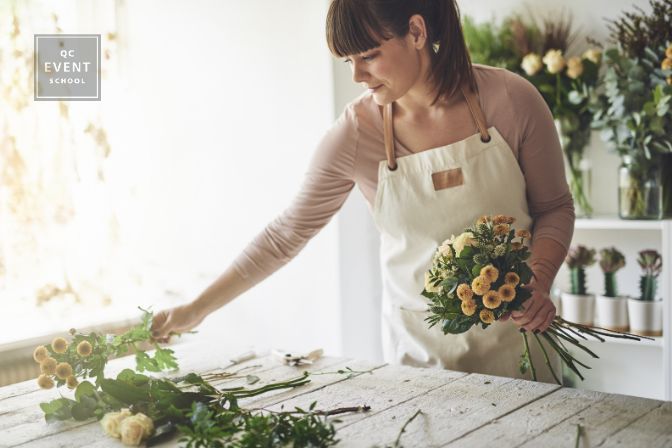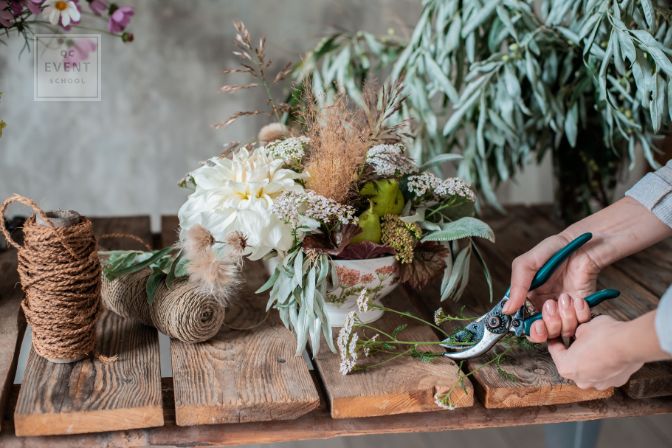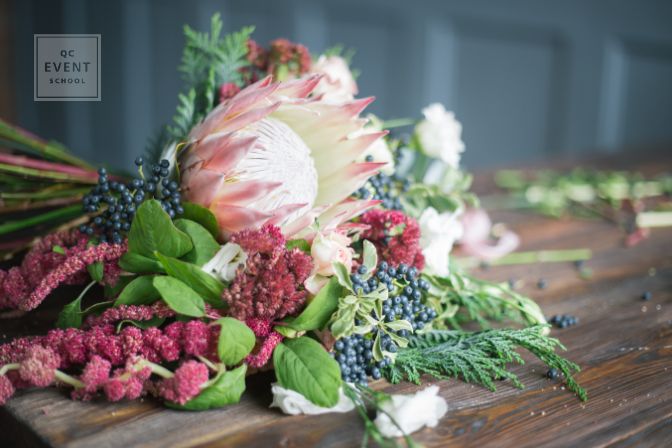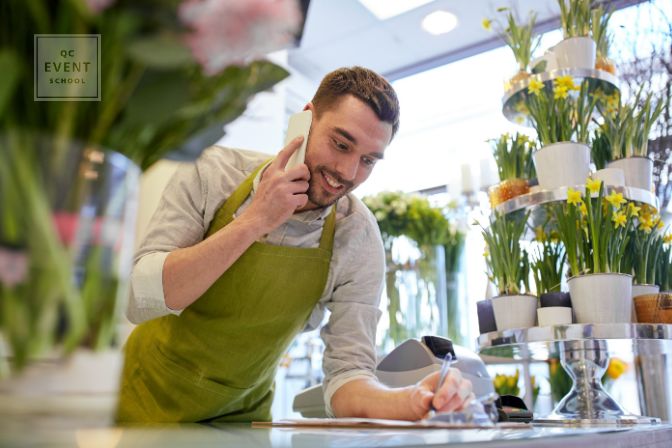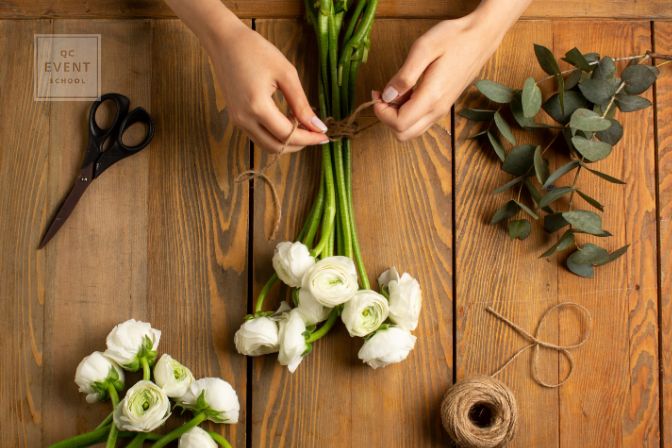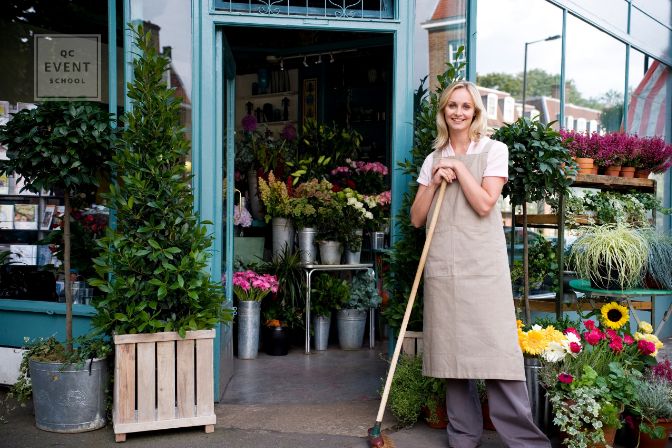
Floral Design, General Tips, Your Event Career
The ULTIMATE Guide on How to Become a Florist
Do you love flowers? Do you have a creative flair? If so, a career in floristry may be perfect for you! In this article, we’ll provide a step-by-step guide on how to become a florist – even if you have no prior experience!
We will also discuss what this career entails, in order to help you better understand if it’s the right choice for you. The beauty of this industry is that it’s constantly growing, and there are plenty of opportunities for those who are passionate about flowers and design. So, whether you’re just starting out in your career journey or simply curious about this field, read on for all the information you need to make a proper decision!
What Is a Florist?
A florist is a professional who arranges and sells flowers. They may work in a brick-and-mortar store, or they may be employed by a floral design company. Some florists also work as freelance designers.
What Does a Florist Do?
The main responsibility of a florist is to create arrangements using fresh flowers. This can include:
- Bouquets
- Corsages
- Boutonnieres
- Centerpieces
- Home decor pieces
- And more!
Florists must have knowledge of different flower types and colors, as well as which blooms are in season. They must also be able to care for the flowers properly so that they remain fresh for as long as possible. In addition to creating arrangements, some florists may also be responsible for delivering them to the customer’s location.
What Qualifications Do You Need to Be a Florist?
There are no formal education requirements to become a florist. However, most employers will require at least a high school diploma or some sort of equivalent. Some floral design programs are available at the post-secondary level, but they are not required in order to start working in this field.
Many florists learn through on-the-job training. That said, however, the most successful floral designers out there rose to the top by proactively expanding their knowledge and skill-set in floristry. The most direct and beneficial way to acquire this expertise is by taking a reputable certification course… Such as the one offered through QC Event School!
We’ll delve a little deeper into that shortly – but in the meantime, you can learn all about QC Event School here!
Why a Floral Designer Certification Will Benefit You
As we mentioned, taking a certified floral design course will benefit you in many ways as you pursue a career in this field. For one, it’ll give you an edge over other candidates who are applying for the same jobs as you – even if they have more experience than you. This is because your certification will show that you’re dedicated to the craft, and that you’ve taken the initiative to expand your skills.
It will also give you access to exclusive resources, including:
- Professional discounts on flowers and supplies
- Tips and tricks for launching your very own business
- Marketing strategy ideas
- Advice for finding new clients and retaining past ones
- A supportive network of like-minded floral designers (such as by joining QC’s free Virtual Classroom on Facebook!)
- And so much more!
How to Become a Floral Designer: Required Skills
In order to be successful in this career, you will need strong creative skills. This includes being able to visualize different arrangements and using your imagination to come up with new designs. You should also have good manual dexterity, as this will come in handy when working with delicate flowers and arrangements.
It’s also important to be able to work well under pressure, as you’ll often be working with deadlines. Furthermore, good customer service skills are a must, since you’ll be interacting with clients on a regular basis. And last but not least, strong organizational skills will help you keep track of your inventory and manage your time efficiently.
If you have all of these skills (or are willing to develop them), then a career in floristry could be the perfect fit for you!
Is Floral Design Hard?
Like with any career, there will be challenges that you’ll face as a florist. However, as long as you’re prepared for them, these challenges can be overcome easily.
One of the biggest challenges that you’ll face is keeping up with the latest trends. This is because trends are constantly changing, and customers will expect you to be up-to-date with the latest designs. To stay on top of current trends, make sure to regularly read magazines and blogs related to the industry.
You’ll also need to be able to deal with challenging customers. This may include those who are unhappy with their arrangements or those who are making last-minute changes to their orders. It’s important to remain calm and polite in these situations, as this will reflect well on you and your business.
Lastly, you’ll need to be able to manage your time efficiently. This is because you’ll often have multiple orders that need to be completed within a certain timeframe. By learning how to better manage your time, you’ll be able to complete all of your orders on time (and with high-quality results).
All that to be said, if you’re prepared to face these challenges, then you’ll thrive on a career in floristry!
Is Being a Florist a Good Career?
There’s no black or white answer to this question, because it really depends on YOU! Here are some questions to consider:
- Do you have a strong interest in flowers and plants?
- Do you enjoy being creative and coming up with new designs?
- Are you good at working with your hands?
- Do you work well under pressure?
- Do you have strong customer service skills?
If you answered “yes” to most (or all) of these questions, then a career in floristry could not only be the right path for you – it’ll likely be a job you truly enjoy doing! Not to mention, if you already have a business in the events industry – such as being an event planner and/or wedding planner – adding floristry services to your repertoire will definitely help take your already successful career to the next level!
Do Florists Make Good Money?
How much you can expect to make as a floral designer will depend on a variety of factors, such as:
- Whether or not you’ve gotten professional training and a reputable certification to your name
- Your location (e.g. big city vs. small town)
- Local competition
- The demand for floristry services in your area
- Whether you’re running your own business or working for someone else
- Whether you’re working as a florist part-time vs. full-time
- If you offer in-person services, virtual services, or a combination of both
- Whether your business offers any additional services as well (e.g. event/wedding planning, event decorating, home decor services, etc.)
- How you set your service rates
- The amount of effort you put into marketing your business, networking, etc.
- Your quality of customer service
- And more.
Average Salaries for Florists
That said, we can give you a general idea of how much you can potentially earn on a yearly basis. The following info is based on several example countries:
- United States: Between approx. $20,100 USD and $43,100 USD annually (Source: Career Explorer)
- Canada: Between approx. $28,000 CAD and $42,000 CAD annually (Source: Payscale)
- United Kingdom: Between approx. £21,600 GBP and £42,500 GBP annually (Source: Talent.com)
- New Zealand: Between approx. $41,599 NZD and $67,800 NZD annually (Source: Salary Expert)
- Australia: Between approx. $41,000 AUD and $60,000 AUD annually (Source: Payscale)
How Much Does a Self-Employed Florist Earn?
As a self-employed florist, your earnings will largely depend on how successful you are in marketing and promoting your business. It’ll also depend on the service rates you set for yourself, as well as the number of clients you’re able to take on.
Of course, if you offer additional services beyond just being a florist (such as event/wedding planning, event decorating, home decor services, etc.), you’ll have the potential to earn even more.
The sky really is the limit when you’re your own boss!
Tips for Earning More Money as a Florist
If you’re looking to maximize your earnings as a florist, here are a few tips to keep in mind:
- Get professional training and certification! This will not only make you more reputable, but it’ll also give you the opportunity to charge more for your services.
- Stay up-to-date with the latest trends! This will not only make your designs more popular with clients; it’ll also help you command higher rates.
- Offer additional services! As mentioned earlier, offering services beyond just being a florist can help you earn more money.
- Find your niche! What is it that makes your designs unique? If you can find a way to stand out from the rest, you’ll be more successful in marketing your business – and ultimately, earning more money.
- Invest in marketing and advertising! The better you are at promoting your business, the more clients you’ll get – and the more money you’ll make!
Tips for Setting Your Service Rates
Now, if you’ve never run your own business before, you might be unsure of how to go about pricing your floral design services for the first time. After all, charging too little will be selling yourself short… But charging too much could alienate prospective customers and send them straight into the arms of your competition.
You obviously don’t want either of these outcomes! So, how should you set your rates properly?
Here are a few tips:
- Do your research! Look at what other florists in your area are charging for similar services. This will give you a good starting point to work from.
- Remember that you can always adjust your rates later if needed! If you find that you’re not getting as many clients as you’d like, it might be time to lower your rates a bit.
- Consider the cost of materials! Make sure you’re charging enough to cover the cost of the flowers, vases, etc. that you’ll be using for each arrangement.
Most importantly, don’t be afraid to charge what you’re worth! As with any other profession, you should be paid for your time, effort, and creativity. If you don’t value your own work, how can you expect anyone else to?
What Are The Pros and Cons of Being a Florist?
Like any other career, being a florist has its own set of pros and cons. Let’s take a look at some of the most notable ones:
Pros
1 – You get to work with flowers every day! This is a huge perk for anyone who loves nature and all things floral.
2 – You’re constantly surrounded by beauty! Not only do you get to work with beautiful flowers, but you also get to create beautiful arrangements that brighten up people’s homes and special occasions.
3 – You have the potential to earn a good income! As we saw earlier, florists can potentially earn a very good wage, especially if they’re self-employed or own their own business.
4 – You have the opportunity to be creative! If you’re someone who loves being creative and working with your hands, then being a florist is definitely the career for you.
5 – You can elevate your existing event/wedding planning business! If you already have a business in event or wedding planning, adding floral design services can be a great way to boost your income and broaden your range of services.
Cons
1 – The work can be physically demanding. You’ll be on your feet all day, lifting heavy boxes of flowers, and dealing with sometimes uncooperative customers.
2 – The work can also be emotionally demanding. Some customers can be very particular about their arrangements, and it can be challenging to meet everyone’s expectations.
3 – You’ll have to deal with the occasional customer complaint. No matter how good you are at your job, there will always be the odd unhappy customer. Learning how to deal with difficult customers is an important part of being a florist.
4 – The hours can be long and irregular. Depending on the season and the demand for your services, you may find yourself working long hours, including weekends and holidays.
All that to be said, if this is a career you’ll be passionate about, the pros definitely outweigh the cons. Not to mention, the “cons” listed above might not even be deterrents for you at all!
What’s In a Florist’s Tool Kit?
Next, let’s take a look at some of the tools of the trade. As a florist, you’ll need:
- A sharp pair of shears (for cutting flowers)
- A good set of knives (for trimming stems and leaves)
- Floral tape (for securing stems)
- Wire (for shaping arrangements)
- Vases and containers of various sizes (for holding arrangements)
- Flowers! Obviously, you’ll need a steady supply of fresh flowers to work with. Depending on your business model, you can either grow your own flowers or purchase them from a wholesaler.
Additionally, if you’re planning on starting your own floral design business, you’ll also need:
- A website, online portfolio, and a social media presence
- Business cards
- A laptop or computer
- A cellphone
- Marketing materials (brochures, flyers, etc.)
- A storage space for supplies
- A delivery vehicle (if you plan on delivering arrangements yourself)
What Do Florists Do With Unsold Flowers?
If you’re thinking of working in a retail setting, chances are you’ve wondered what happens to unsold flowers at the end of the day. While some shops may simply throw them out, there are actually quite a few things you can do with them instead!
Here are a few ideas:
- Donate them to a local nursing home or hospital
- Give them away to friends, family, or co-workers
- Use them to create smaller arrangements that can be sold at a discounted price
- Compost them
This is also one of many reasons why alternative floral arrangements have become increasingly popular over the years. Made with dried or artificial flowers, these arrangements have a much longer shelf life than traditional arrangements made with fresh flowers.
If you’re interested in specializing in artificial flowers (such as silk florals, for example), this would definitely be a perk. You wouldn’t ever have to worry about them going to waste if they didn’t sell!
How Much Does It Cost To Start a Career as a Florist?
By this point, you may be thinking, “Can I actually afford to become a florist?”
The good news is, YES, you can! Starting a career as a florist is relatively inexpensive. The majority of the supplies you’ll need can be purchased for less than $500. Furthermore, if you don’t intend to start your own business, then there’s no need for things like marketing materials or a delivery vehicle.
Of course, the biggest expense will be the flowers themselves. Depending on where you purchase your flowers and how often you need to restock, your flower bill can range from a few hundred dollars to several thousand dollars per month.
Cost of Starting a Floral Design Business
Now, what if you do want to start your own company? What sort of investment will you be looking at in order to get the ball rolling?
Here’s a quick breakdown of some of the major startup costs:
- Business licenses and permits: $100 – $500
- Insurance: $500 – $2000
- Website design and hosting: $100 – $300/year
- Marketing materials (business cards, flyers, etc.): $200 – $1000
- Delivery vehicle: ~$5000 (or you can use your personal vehicle)
- Storage space for supplies: ~$50/month
Of course, these are just estimates. The actual cost of starting your own floristry business will depend on a number of factors, including the size and scope of your business, where you’re located, and the specific licenses and permits required in your area.
How to Become a Florist in 10 Easy Steps
Now that we’ve answered some of the most common questions about becoming a florist, let’s get down to business and take a look at the steps you’ll need to take in order to make your dream a reality!
Here’s a quick overview of what we’ll be covering:
- Do Your Research
- Get a Formal Education
- Join a Professional Organization
- Find an Apprenticeship or Internship
- Start Your Own Business
- Market Your Business
- Stay Up-To-Date on Industry Trends
- Grow Your Business
- Hire Employees
- Become a Master Florist
Step One: Do Your Research
The first step to becoming a florist is, unsurprisingly, to do your research. This means learning about the different aspects of the job and gaining a better understanding of what it entails.
Start by reading articles (like this one!), watching videos, and talking to people who are already in the business. This will help you get a feel for what a career in floristry might look like and allow you to decide if it’s the right fit for you.
You should also take some time to explore the different types of flowers and arrangements that are available. Familiarizing yourself with the materials you’ll be working with will make the transition into your new career much smoother.
Another thing we recommend looking into is the type of floral designer you want to be in general! For instance, there are those who specialize in weddings, funerals, and other special occasions. There are also designers who focus on more everyday arrangements, like bouquets and centerpieces.
Knowing what type of florist you want to be will help you focus your research and make the transition into your new career much easier.
Step Two: Get a Formal Education
The next step is to get properly trained and certified in floral design. While you technically don’t need a formal education to become a florist, as we mentioned earlier, it’ll give you a significant leg-up on the competition!
There are a number of ways to go about this, but the most popular option is to take an accredited course. These days, reputable floral design programs can be found both in-person and online. QC Event School’s Floral Design Course, for example, is entirely self-paced and done right from the comfort of home. As a result, you can complete it in as little as 3-6 months!
A Look Into QC Event School’s Floral Design Course
This 7-unit online course will provide you with a globally-recognized International Floral Design Professional (IFDP) certification upon graduating. Throughout this program, you’ll learn all about:
- The history of floral design
- Different career paths you can take as a certified florist
- The most common floral arrangements you’ll create throughout your career, and how to actually make them
- How to work with various types of flowers and greenery
- Plant anatomy and plant care
- How to use the various items we listed in your tool kit earlier
- The principles and elements of design
- How to develop a floral design plan for every element of your design
- Elevating your floral designs via decorative accessories and advanced techniques
- Working with faux flowers
- And more!
Plus, in Unit F, you’ll learn everything you need to know about starting (and operating) a thriving floral design business of your very own!
Interested in this exciting opportunity? Here’s our full Floral Design Course page with even more info for your consideration!
Step Three: Join a Professional Organization
The third step to becoming a florist is to join a professional organization. The American Institute of Floral Designers (AIFD), the Australian Floral Art Association (AFAA), the Canadian Professional Floral Designers Association (CPFDA), the Floral Art Society of New Zealand (FASNZ), and the British Florist Association (BFA) are all well-known examples.
Becoming a member of notable organizations can have many positive impacts on your career! Firstly, it’ll allow you to network with other professionals in the industry. Secondly, you’ll also have access to exclusive resources and learning opportunities. AIFD, for example, offers an online floral design library, which includes everything from articles and videos to hands-on tutorials.
Depending on the membership, you might also be able to take advantage of discounts on select schools and/or courses, products, and events related to floral design. So, it’s definitely worth considering if you’re serious about starting a career in this field!
Step Four: Find an Apprenticeship or Internship
Once you’ve gotten certified and joined a professional organization, the next step is to find an apprenticeship or internship. While not required, completing an apprenticeship is a great way to get your foot in the door and gain some real-world experience.
If you’re not sure where to start, reach out to your local florists and see if they offer any type of apprentice program! You can also check with larger companies, like Whole Foods, as they tend to have their own in-house floral departments.
Another option at your disposal is to do a little digging online. There are all sorts of articles out there with helpful advice on finding apprenticeships and/or internships – as well as potential local opportunities!
Step Five: Start Your Own Business
From here, it’ll be time to start your own business! This can be anything from running your own brick-and-mortar shop to working as a freelance designer out of your home.
Of course, starting any kind of business comes with its fair share of challenges. But thankfully, there are plenty of resources available to help you get started. The Small Business Association (SBA), for example, offers free counseling and training programs to small business owners across the United States.
If you’re not sure where to begin, take some time to browse the SBA’s website – or reach out to your local chamber of commerce. They should be able to point you in the right direction and help get your floral design business up and running in no time!
5 Quick Tips When Starting Your Business
Tip #1: Pick The Right Business Name
Your business name is important. After all, it’ll be one of the first things potential customers see. So, you want to make sure it’s catchy and memorable!
Remember: a bad business name can tank your career before it’s even started.
Importantly, you also want to make sure it accurately represents what your business is all about. Take some time to brainstorm a few different options before settling on the perfect name for your floral design business. And don’t forget to have it registered – otherwise, there’s nothing stopping someone else from swooping in and stealing it from you!
Tip #2: Determine Your Brand
In addition to your business name, you’ll also need to determine your brand. This includes everything from your logo and tagline to the colors and fonts you use on your website and marketing materials.
Your brand should be unique, professional, and consistent across all channels. It’s also important that it speaks to your target audience!
Not sure where to start? Check out Shopify’s helpful guide on branding your business.
Tip #3: Know Your Target Market
Who is your target market? This is an important question to ask when starting any business – but it’s especially important when starting a floral design business!
Your target market will determine everything from the type of flowers you sell to the price point of your arrangements. So, it’s important to take some time to really think about who you want to sell to.
For instance, are you looking to appeal to budget-conscious brides? Or are you aiming for a more high-end clientele? Once you’ve answered this question, you’ll be well on your way to determining your target market!
Tip #4: Create a Business Plan
Next up, you’ll need to create a business plan. This document will outline your business goals, strategies, and how you plan on achieving them.
If you’ve never put together a business plan before, that’s alright. There are tons of free templates available via a quick Google search. Just make sure that it clearly outlines your:
- Business goals
- Target market
- Marketing and advertising strategies
- Pricing structure
- Estimated expenses
Tip #5: Get The Right Insurance
When starting any kind of business, it’s important to have the right insurance in place. This will protect you (and, crucially, your business) in case of accidents, injuries, or damages.
There are all sorts of policies available, so be sure to do your research and find the one that best suits your needs. That said, these are the 4 most common types of business insurance you’ll come across:
- Property insurance: This covers damages to your property, as well as any equipment or inventory you keep on site.
- Liability insurance: This protects you in the event that someone is injured on your property or by one of your products.
- Business interruption insurance: This reimburses you for lost income if your business is forced to close due to damages from a covered event (like a fire or severe weather).
- Workers’ compensation insurance: This is required in most states if you have employees. It covers medical expenses and lost wages for employees who are injured on the job.
Step Six: Market Your Business
Now that you’ve got all the logistical stuff out of the way, it’s time to start marketing your business!
There are a number of ways to do this, but some of the most effective include:
Creating a website
Your website should be professional and easy-to-navigate. Be sure to include clear calls-to-action (like “book now” or “contact us”) so potential customers know how to get in touch with you. Furthermore, ensure that it contains the following key information:
- An ‘About Me’ section where potential clients can get to know you
- Your professional qualification(s) as a florist
- Contact info, such as your phone number, email, physical address (if applicable), etc.
- A list of your floral design
- A list of any additional services your business also offers
- Your service rates, should you wish to publicly display that information
- Your professional floristry portfolio
- Client testimonials/reviews
- Links to your social media accounts
- An option for online booking
Getting active on social media
In today’s digital age, social media is a powerful marketing tool. Not only does it give you a platform to showcase your work, but it also allows you to connect with potential customers from all over the world.
When it comes to promoting your business on social media, there are a few key things to keep in mind:
- Use high-quality, original images that accurately represent your brand
- Post regularly, but don’t spam your followers’ feeds
- Engage with other users – like and comment on their posts, and share relevant content from other accounts
- Use hashtags judiciously – too many can be off-putting, but a few well-chosen ones can help you reach a wider audience
Joining relevant online communities
Another great way to market your business is by joining relevant online communities through platforms such as Facebook, Instagram, Twitter, etc. This will help you connect with other professionals in your field, as well as potential customers. When joining these communities, be sure to:
- Engage in discussion – don’t just promotional content!
- Add value – share your expert insights and helpful advice!
- Be professional – remember, these are potential customers you’re interacting with!
Investing in Paid Advertisements
Another option is to invest in paid advertisements. This can be a great way to reach a larger audience. Plus, you can target your ads specifically to people who are likely to be interested in your services (e.g., those living in your city/state, of a certain age range, etc.).
When it comes to paid advertising, there are a few different platforms you can use. The top 5 we recommend targeting are Google Ads, Facebook Ads, Instagram Ads, Pinterest Ads, and TikTok Ads.
Other Ways to Market Yourself
There are a number of other marketing strategies you can use to promote your florist business. These include things like:
- Attending trade shows and conventions
- Participating in local events (like farmer’s markets or craft fairs)
- Networking with other professionals in your field
- Lending your floristry skills to a stylized photoshoot
- Getting involved with local charities or other organizations
- Creating a blog or podcast about your industry experience/knowledge
- Create the floral arrangements for an event or wedding you organize for a client
Basically, the sky’s the limit… So, get creative and think outside the box!
Fun Fact: QC Event School’s Accelerate Your Business Workshop can also teach you everything you need to know about top-notch marketing strategies – along with a ton of other valuable business know-how!
Step Seven: Stay Up-To-Date on Industry Trends
The next step to becoming a successful florist is to stay up-to-date on industry trends. After all, remaining current is pivotal to any career. This is because, as industries evolve, so too do the skills required to excel within them.
So, how can YOU stay on top of trends in the floral industry?
Here are a few suggestions:
- Keep an eye on social media – what sorts of designs and arrangements are becoming popular?
- Subscribe to industry-related news sources or magazines
- Read floral design magazines (e.g., Florists’ Review)
- Attend trade shows and conventions
- Further your education by taking classes or workshops from experienced professionals
- Join online communities and forums related to your field
By staying up-to-date on industry trends, you’ll be able to keep your work fresh and exciting – which will, in turn, help you attract new clients! Plus, it’s just plain fun!
Step Eight: Grow Your Business
The final step to becoming a successful florist is to grow your business. After all, what’s the point of putting in all this work if you’re not going to see any results?
So, what can you do to grow your florist business? Here are some ideas off the top of our head:
- Start selling your floral arrangements online
- Create a loyalty program for repeat customers
- Offer discounts or special promotions
- Participate in local events
- Collaborate with other industry experts, such as on a styled photoshoot
- Get involved with charities or other organizations in your community
- Combine your floristry skills with other complementary services, such as event/wedding planning, event decor, etc.
Thinking of adding floral design services to professional planning services? Check out QC Event School’s full list of event and wedding planning certification courses – all of which can be completed online in as little as 3-6 months!
Step Nine: Hire Employees (If You Haven’t Already)
Eventually, when the time is right, you might consider hiring some employees for your business! This makes sense – since, as your company grows, you’ll need help keeping up with the higher and higher demand.
Never hired employees before?
Start by writing a clear and concise job description. This will help you attract the right candidates. Next, create a list of interview questions that will help you get to know the candidates and their qualifications.
After that, don’t forget to check references! This step is often overlooked but it’s very important.
Now, from a legal standpoint, you’ll want to make sure that when you bring on employees, you’re doing things by the book. This means understanding and following all relevant employment laws in your jurisdiction. If you’re not sure what these employment laws are, we strongly recommend doing some research before putting up any job postings.
That said, by following the tips above, you should have no problem finding and hiring the perfect candidate for your business!
Step Ten: Become a Master Florist
Aaaaand presto – you’re now a master florist!
By following the steps in this guide, you should have all the tools and knowledge you need to become a florist, even if you have little to no experience. By following these ten steps, you’ll be well on your way to starting a successful career in the floral industry!
Do you have any questions about becoming a florist? Let us know in the comments below and we’ll do our best to answer them! And if you found this article helpful, please share it with your friends!
After all, sharing is caring! 😉
